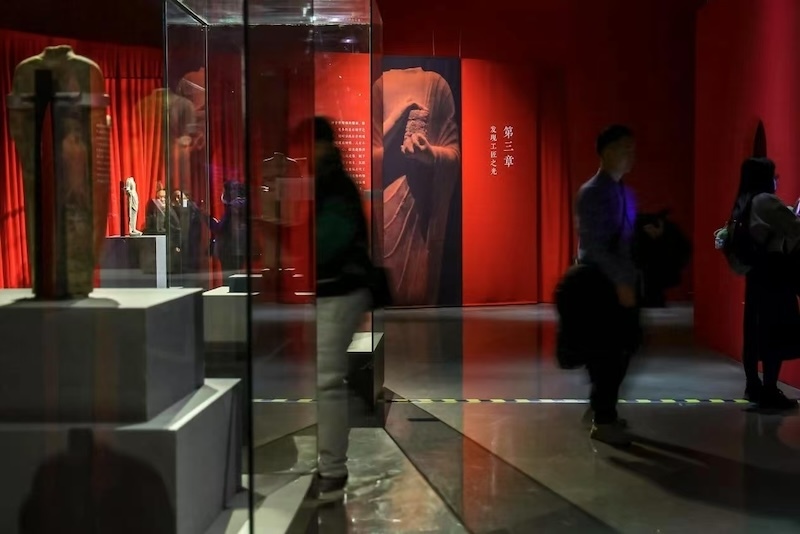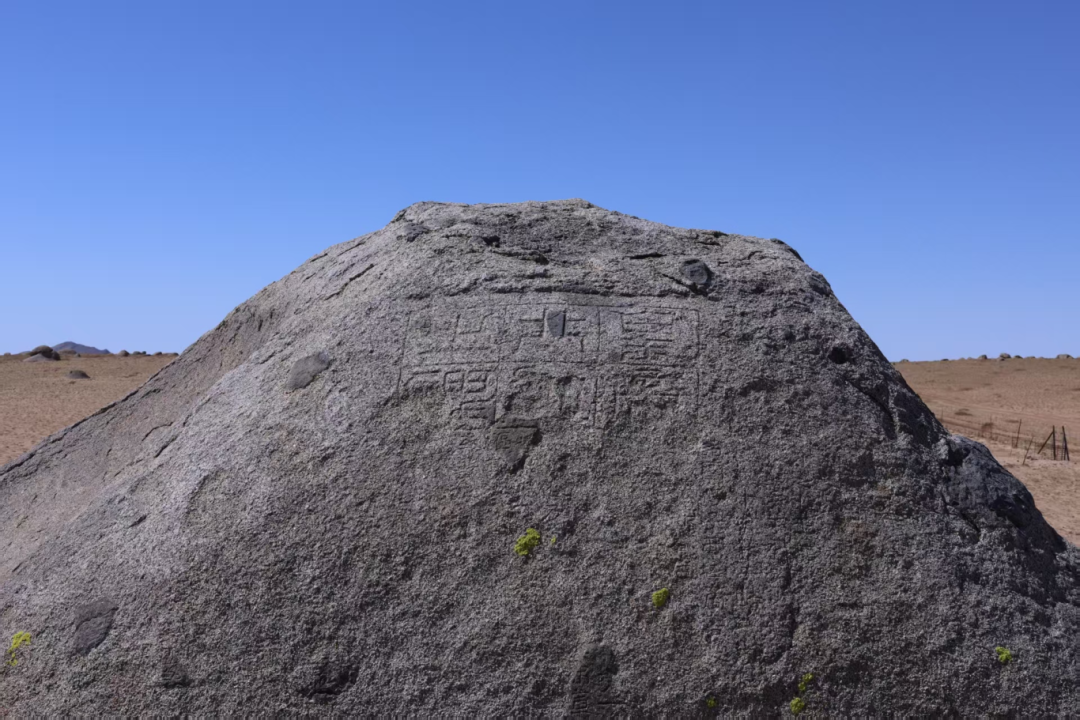
From the fine carvings of the Northern Wei Dynasty to the smooth and round shapes of the Sui Dynasty, the Qingzhou Buddha statues embody the ancient people's profound understanding of art and life.
"Seeing the Smile - Ancient Qingzhou Sculpture Art Exhibition" opened recently at Beijing Guardian Art Center. The exhibition presents nearly 50 Buddhist statues from Qingzhou and its surrounding areas. They are not only precious witnesses of ancient Chinese sculpture art, but also use the unique artistic expression of "Qingzhou Smile" to outline a kind of warmth and tranquility that transcends time and space. When gazing at the smiles of these thousand-year-old sculptures, one can feel a resonance and emotion that transcends time and space.

Exhibition site
In line with the atmosphere of the Spring Festival, the red exhibition environment shows the solemn appearance of the Buddha statues. The exhibition brings together nearly 50 Buddha statues from the Wei, Jin, Southern and Northern Dynasties, which come from Qingzhou Museum, Linqu Museum, Anqiu Museum, Shouguang Museum, Boxing County Museum, etc. Among them, the Buddha statues at the Longxing Temple Ruins in Qingzhou, Shandong Province are even more renowned as "China's 100 Great Archaeological Discoveries of the 20th Century" and "Masterpieces that Rewrite the History of Oriental Art".
The curators said that they hope to use this exhibition to present to the audience the changes in the style of statue art over a period of about 500 years from the Northern Wei Dynasty to the Sui Dynasty, and to interpret a sculpture art epic that spans time and space.

Exhibition site
Qingzhou style, a warm smile that spans thousands of years
"We came into this world crying, but we can walk into eternity with a smile." A line from the 2020 CCTV program "If National Treasures Could Talk" drew everyone's attention to the batch of statue art treasures unearthed from the Longxing Temple site in Qingzhou, Shandong in 1996.
In 1996, more than 400 Buddhist statues of various types from the Northern Wei Dynasty to the Northern Song Dynasty were unearthed at the Longxing Temple site (south of Qingzhou Museum). This discovery was listed as the top ten archaeological discoveries in China that year and one of the 100 major archaeological discoveries in China in the 20th century, which caused a sensation both at home and abroad. This batch of statues presents the extremely high artistic level of the ancients and has been the focus and discussion of scholars at home and abroad since its discovery.

Excavation site of Longxing Temple cellar
However, the statues in Qingzhou Longxing Temple were not isolated cases in Shandong during the Northern and Southern Dynasties. Before and after this, many statues were discovered in some important Buddhist sites in other areas around Qingzhou, including Boxing Longhua Temple, Shouguang Longxing Temple, Linqu Mingdao Temple, Zhucheng Longxing Temple, and Anqiu Bicheng area. When compared with the statue remains of Qingzhou Longxing Temple and other places from the same period, keen scholars realized that the artistic statues centered on Qingzhou, including Shouguang, Linqu, Anqiu, Boxing and other surrounding areas, showed important convergence of artistic styles, both in terms of the overall structure of the shape and the treatment of local details. These clues are telling us that in the ancient Qingzhou area during the Northern and Southern Dynasties, there was a "regional art style" based on common aesthetic orientation and carving techniques. Scholars usually refer to this style as the "Qingzhou style."

Northern Dynasties Bodhisattva
Different from the "solemnity" of ordinary statues, the touching "Qingzhou smile" has become the most charming feature of this group of statues. This art that combines natural realism and solemn beauty makes every audience intoxicated and also lays the foundation for the formation of this exhibition.

Painted stone statues of Bodhisattvas from the Northern Qi Dynasty to the Sui Dynasty

Northern Qi Dynasty Half-length Carved Bodhisattva
When archaeologists were sorting out the "Qingzhou style", they gradually summarized several typical artistic styles, especially the back-screen statues and single-body round sculptures, which are the most typical categories of the "Qingzhou style".
The second part of the exhibition presents different types and periods of back-screen statues, as well as detailed treatments based on these types. Styles characterized by "dragon holding lotus" and "one Buddha and two Bodhisattvas" constitute important features of the "Qingzhou style" back-screen statues. The "overlapping" and "soft" clothing folds present different characteristics of single round sculptures. These have not only become important bases for scholars to classify the "Qingzhou style", but also important features for the audience to identify the "Qingzhou style".

Northern Wei Dynasty statues

A Gilded and Painted Stone Figure of a Bodhisattva from the Eastern Wei Dynasty
Qingzhou Smile and the Charming Possibilities of "Cao Yi Emerging from Water"
In the statues of the Northern Qi Dynasty, new changes appeared in the faces and head shapes of Buddhas and Bodhisattvas. Soft and full lines replaced the obvious ups and downs. At the same time, the round heads and slightly open and lowered eyes revealed a more subtle emotional expression.

Northern Dynasty Buddha Head

Northern Qi statues
This is also the more well-known feature of the "Qingzhou Style". During the Northern and Southern Dynasties, the craftsmen in Qingzhou area portrayed the faces of Buddha and Bodhisattva statues. Compared with statues in other regions, the faces of statues in ancient Qingzhou area are softer and more intimate. Different from the common sense of "distance" in Buddhist statues we often see today, "Qingzhou Style" statues can focus more on showing the "elegance" rather than the "solemnity" of Buddhist sculpture art.

A Northern Qi painted stone statue of a standing Bodhisattva
The rounded and full style of the Northern Qi Dynasty seems to be easily linked to the records of "Cao Yi Chu Shui" in ancient documents, but what really fascinates people are the Buddhist robes of the Northern Qi Dynasty that fit the body completely without any trimming of the lines, and there are also Buddhist robes with slight lines outlining the shape. The two styles are like the dynamic and static states of water, a calm lake and ripples, and together they present the fascinating possibilities of "Cao Yi Chu Shui" of the Northern Qi Dynasty.

Standing Bodhisattva Statue of Northern Qi Dynasty
Coming to the Eastern Wei period, the lines of the statues at this time make people feel that after the technical accumulation of the Northern Wei period, the carving skills became mature and fluent in this period. The craftsmen at this time began to have more flexible "creative" space within the program. The head and body proportions of a Buddha statue in the exhibition are different from the others, but the lines of its clothing are particularly smooth and free and easy.

Eastern Wei statues
"Round sculpture" makes it possible to view Buddha statues in more ways. Originally, statues with back screens could only be viewed from the front, but now the statues can be placed in the center of the viewing route. Ancient believers could surround the statues and walk back to the visual center of the next statue, which is very different from the viewing method of statues with back screens.

Details of Eastern Wei statues
Discover the Light of Craftsmen
The Qingzhou theme style is a very delicate carving. In addition to the relatively unified modeling style, there is more exquisite treatment of details. The craftsmen active in the Qingzhou area at that time handled the details in a similar and different way, showing amazing ingenuity.
The request for statues may have been made by officials and businessmen, but the completion and life of the statues were actually done by the craftsmen who left no name and remained silent in history. The third part of the exhibition mainly shows the ingenuity of ancient craftsmen in handling the details of different statues from their perspective. Through many detailed comparisons and content development, the audience can more intuitively appreciate the beauty of the details of cultural relics.
An unfinished Buddha head in the local area was buried because it was estimated that the carving was stopped urgently for some reason. The face and facial features of this Buddha statue were carved, but only the spiral hair and neck were not completed (if it is regarded as a head). At the same time, this "semi-finished product" seems to tell us a new story, that is, the order of ancient craftsmen carving Buddha heads was to determine the facial features and face first, and then modify the hair and other accessories. This is an abrupt end to the carving results, and also an abrupt end to the carving process.

Unfinished Buddha statue
The greatest charm of Qingzhou statues lies in the charming smiles carved out of stones. Smiles have always been the most intuitively perceived emotion. When a direct, warm or restrained smile is presented, even ordinary audiences who have no research on art history can intuitively feel the charm of the statues.

Northern Dynasties Standing Buddha
Some Qingzhou Buddha statues also show a considerable degree of gilding and painting. This relatively well-preserved state tells us that the statues in ancient Qingzhou originally had rich painted decorations. Faced with these cultural relics that still retain gilding and painting, after they were unearthed, the museum staff also cooperated with the Qin Shihuang Mausoleum Terracotta Warriors and Horses Museum and other domestic institutions with top cultural heritage protection technology to preserve the statues' paintings as much as possible, so that everyone can see the gorgeous original appearance of the statues.

Colored and gilded Buddha statue

Colored and gilded Buddha statue
From the "thick robes and wide belts, thin and clear images" of the Northern Wei Dynasty to the "Cao robes emerging from water" of the Northern Qi Dynasty, these statues from the Northern Wei Dynasty to the Sui Dynasty spanned five hundred years, presenting the exquisite skills, evolution and development of the style of Chinese sculpture art. In this exhibition, the audience will feel the "smile" that spans thousands of years of time and space, and understand the ancients' understanding of art and life.
The exhibition will be on display until March 12.
